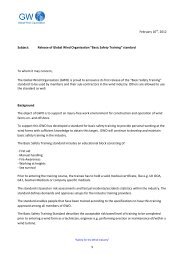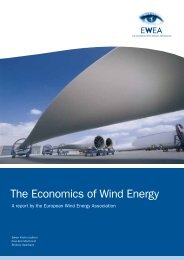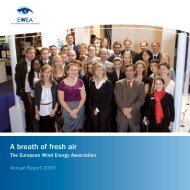Offshore Electricity Infrastructure in Europe - European Wind Energy ...
Offshore Electricity Infrastructure in Europe - European Wind Energy ...
Offshore Electricity Infrastructure in Europe - European Wind Energy ...
You also want an ePaper? Increase the reach of your titles
YUMPU automatically turns print PDFs into web optimized ePapers that Google loves.
esults<br />
• A three-leg <strong>in</strong>terconnector where the teed-<strong>in</strong> w<strong>in</strong>d<br />
farm (hub) is also connected to Germany. This<br />
design thus l<strong>in</strong>ks the Netherlands, Denmark and<br />
Germany allow<strong>in</strong>g multilateral electricity trade.<br />
Investigated cases<br />
Seven different cases are <strong>in</strong>vestigated (Table 4.5 and<br />
Figure 4.19). The objective is to evaluate:<br />
• Whether the <strong>in</strong>clusion of a w<strong>in</strong>d farm on the cable<br />
is beneficial. For this assessment the tee<strong>in</strong>g-<strong>in</strong><br />
of two different w<strong>in</strong>d farm/hubs is analysed separately:<br />
Butendiek (400 MW) and HDE002 Cluster<br />
(1,300 MW). (Case 2 and Case 7),<br />
• Whether develop<strong>in</strong>g a l<strong>in</strong>k between the Cobra cable<br />
and a large shore-connected German w<strong>in</strong>d farm<br />
cluster (HDE002) is beneficial – the so called threeleg<br />
configuration (Case 3 and Case 4),<br />
• Whether the connection capacity of the German<br />
w<strong>in</strong>d farm cluster HDE002 to shore can be reduced<br />
<strong>in</strong> capacity (different sizes <strong>in</strong>vestigated) by <strong>in</strong>troduc<strong>in</strong>g<br />
a l<strong>in</strong>k to the Cobra cable (Case 5 and Case 6).<br />
Costs and benefits are compared aga<strong>in</strong>st the Hub<br />
Base Case 2030 (Case 1).<br />
Costs and benefits<br />
Figure 4.20 shows the results of the cost-benefit<br />
analysis for the Cobra cable case study. It is possible<br />
to conclude that the <strong>in</strong>clusion of a w<strong>in</strong>d farm on<br />
the Cobra cable is beneficial for all cases (see next<br />
section).<br />
• Three-leg <strong>in</strong>terconnector is beneficial.<br />
The results show that for higher connection capacities<br />
from the w<strong>in</strong>d farm to the Cobra cable (i.e. the<br />
more German w<strong>in</strong>d that can be sent to either the<br />
Netherlands or Denmark), the benefits are higher.<br />
• Connect<strong>in</strong>g the w<strong>in</strong>d farms only to the Cobra cable<br />
and not to Germany creates the most beneficial<br />
cases - even if the capacity of the w<strong>in</strong>d farm is higher<br />
than the capacity of the Cobra cable.<br />
• Tee<strong>in</strong>g-<strong>in</strong> the large w<strong>in</strong>d farm cluster (almost double<br />
the capacity of the Cobra Cable) yields the biggest<br />
net benefit. This proves the conclusion on splitt<strong>in</strong>g<br />
the w<strong>in</strong>d farm to-shore connection and connect<strong>in</strong>g<br />
it to two separate countries, as discussed <strong>in</strong><br />
Section 4.4.1.<br />
Discussion<br />
It may seem surpris<strong>in</strong>g at first sight that the tee-<strong>in</strong><br />
design is beneficial for all cases. However, consider<strong>in</strong>g<br />
the overall power system configuration, the explanation<br />
is rather simple. At times of high w<strong>in</strong>d generation<br />
<strong>in</strong> Northern <strong>Europe</strong>, German electricity prices are lower<br />
than Danish and Dutch electricity prices. This is due to<br />
the simple market logic that w<strong>in</strong>d energy is generated<br />
at almost zero marg<strong>in</strong>al costs and therefore lowers<br />
spot market prices <strong>in</strong> Germany significantly 24 .<br />
Due to these price gradients it is beneficial to export<br />
electricity from Northern Germany. This of course also<br />
holds for offshore w<strong>in</strong>d energy that can be transmitted<br />
to neighbour<strong>in</strong>g countries <strong>in</strong>stead of be<strong>in</strong>g fed<br />
<strong>in</strong>to the ma<strong>in</strong>land grid where low electricity prices give<br />
low returns. This is <strong>in</strong> particular the case for northern<br />
Germany: with massive onshore and offshore w<strong>in</strong>d<br />
power capacity, there will often be excess w<strong>in</strong>d power<br />
generation dur<strong>in</strong>g periods of high w<strong>in</strong>d which lowers<br />
the spot market prices. The w<strong>in</strong>d power is therefore<br />
transmitted to the Netherlands or to Denmark where<br />
higher prices promise higher returns. Accord<strong>in</strong>g to the<br />
model, this is more beneficial than an <strong>in</strong>terconnection<br />
between the latter countries 25 .<br />
This conclusion is supported by the case-<strong>in</strong>dependent<br />
model where it was shown that <strong>in</strong>creas<strong>in</strong>g the connection<br />
capacity to the country which usually has the<br />
highest prices is the most beneficial option (section<br />
4.4.1). Follow<strong>in</strong>g this reason<strong>in</strong>g and tak<strong>in</strong>g <strong>in</strong>to account<br />
the results from the case-<strong>in</strong>dependent model,<br />
the most promis<strong>in</strong>g grid design solution is to connect<br />
some of the German w<strong>in</strong>d farms to two or three neighbour<strong>in</strong>g<br />
countries. With a relatively modest extra cost<br />
24 The model of course allows trade exchange across national borders similar to today’s coupled electricity market. However <strong>in</strong>terconnection<br />
capacity is limited and therefore high w<strong>in</strong>d power generation <strong>in</strong> Germany first of all lowers the electricity prices with<strong>in</strong> the<br />
German boundaries.<br />
25 In Germany there is a strong need for onshore re<strong>in</strong>forcement between Northern Germany and the Southern part. In the model,<br />
planned onshore re<strong>in</strong>forcement is already taken <strong>in</strong>to account and the offshore w<strong>in</strong>d farms are connected deep <strong>in</strong>land. However,<br />
the massive w<strong>in</strong>d energy deployment <strong>in</strong> the North still leads to excess energy and low prices. In case the onshore bottlenecks are<br />
solved, this might have an impact on the benefits of the tee-<strong>in</strong> solution.<br />
56 <strong>Offshore</strong>Grid – F<strong>in</strong>al Report









